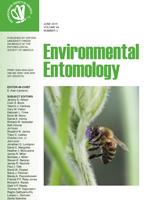Row spacing in agricultural systems can influence crop yield as well as pest and predator abundances. Soybean (Glycine max L. Merrill) growers in Maryland typically plant in narrow (∼19 cm), medium (∼38 cm), or wide (∼76 cm)-spaced rows, and there is a general lack of information on how these row-spacing schemes influence arthropod abundance and soybean yields. A study was conducted during two growing seasons to determine the effect of soybean row spacing and planting date (early and late) on soybean arthropods and yield. Despite a great deal of variation in arthropod responses to row spacing, and interactions between row spacing and study year, leaf-feeding herbivores were generally more abundant in narrow-spaced soybeans. All arthropod functional groups were more abundant, and yield was greater in early-planted soybeans relative to late-planted soybeans. Potential causes and implications of these finding are discussed.
How to translate text using browser tools
1 June 2015
Can Row Spacing Influence Arthropod Communities in Soybean? Implications for Early and Late Planting
Amanda L. Buchanan,
Emily Zobel,
Jermaine Hinds,
Armando Rosario-Lebron,
Cerruti R. R. Hooks
ACCESS THE FULL ARTICLE
It is not available for individual sale.
This article is only available to subscribers.
It is not available for individual sale.
It is not available for individual sale.

Environmental Entomology
Vol. 44 • No. 3
June 2015
Vol. 44 • No. 3
June 2015
crop pests
Glycine max
row spacing
soybeans




